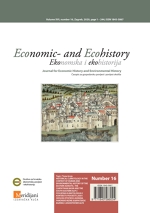Carpathian Basin – The Winner of the Little Ice Age Climate Changes: Long-Term Time-Series Analysis of Grain, Grape and Hay Harvests Between 1500 and 1850
Carpathian Basin – The Winner of the Little Ice Age Climate Changes: Long-Term Time-Series Analysis of Grain, Grape and Hay Harvests Between 1500 and 1850
Author(s): Lajos RáczSubject(s): Agriculture, Energy and Environmental Studies, Economic history, Environmental interactions, 16th Century, 17th Century, 18th Century, 19th Century
Published by: Društvo za hrvatsku ekonomsku povijest i ekohistoriju - Izdavačka kuća Meridijani
Keywords: climate history; environmental history; agrarian history; Little Ice Age; Carpathian Basin;
Summary/Abstract: During the Little Ice Age, the climate became cooler in most of Europe, and the growing season shortened with a decline in the harvest of crops, which resulted in a general decline in living opportunities. However, the findings of the present study reveal that the situation in the Carpathian Basin was somewhat different. The results of our research suggest that Transdanubia, the most western one of the four macro-regions in the Carpathian Basin, was undoubtedly the greatest beneficiary of the wet climate of the Little Ice Age. The agricultural production of the Upper Hungary and the Great Hungarian Plain, as reflected by the indices I was using, was moderately positive. However, in Transylvania, the yields of grain and hay were below contemporary expectations. The diverse landscape certainly helped the Transdanubian macro-region to achieve excellent adaptability. The reason for its success may be that the lack of precipitation is the most critical bottleneck in the agriculture of the Carpathian Basin. The essential feature of the climate change brought about by the Little Ice Age in the Carpathian Basin was the increase in precipitation. Our findings show that it was the Little Ice Age, and especially its wet climate, that on average provided relatively favourable conditions for the balanced performance of agriculture in the Carpathian Basin in the long-term, in the Transdanubian region in particular. The wet climate played a crucial role in the low frequency of crop catastrophes in the 18th a nd 19th centuries. Moreover, the mosaic structure of traditional agriculture (arable and grazing land, orchards, vineyards, meadow farming and fishery) improved the resilience of local and regional economy in the Carpathian Basin. This diverse system characterized agriculture in the study area until the mid-19th century, making it more resilient than modern agriculture.
Journal: Ekonomska i ekohistorija - Časopis za gospodarsku povijest i povijest okoliša
- Issue Year: 2020
- Issue No: 16
- Page Range: 81-96
- Page Count: 16
- Language: English

